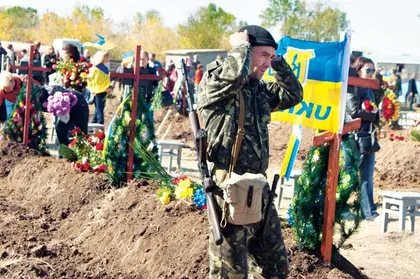More than 107 soldiers were killed there, Defense Minister Valery Heletey said in an interview last month. But Yaroslav Zhylkin, head of a group that tracks war casualties, said volunteers who recently returned from Donetsk Oblast’s Ilovaisk found more than 150 dead bodies, many of which were not officially accounted for. He thinks they left behind at least as many corpses.
“My feeling is that there is at least the same number remaining there,” he told the Kyiv Post.
- Find the newest Ukraine news pieces that came out today.
- Russian Losses in Ukraine War
JOIN US ON TELEGRAM
Follow our coverage of the war on the @Kyivpost_official.
Zhylkin, whose team received a permit from Kremlin-backed insurgents to pick up the Ukrainian dead, said searchers found most of the corpses near the town of Starobeshevo, where a column of Ukrainian troops was fired on by the Russian army in violation of agreements that they would be allowed to leave their encirclement.
Ilovaisk, a town of 16,000 people, was liberated on Aug. 19 by Ukrainian fighters of the Donbas, Dnipro, Azov and Shakhtarsk volunteer battalions. The location was considered to be a strategic point for further attack on separatist-controlled Donetsk, but instead it turned into the deadly trap.
While most of Ukraine’s volunteer battalions were formed as special police units, taking a support role to the army, they became the main combat force in Illovaisk and were supported by the 51th and 92nd army brigades.
A numbers of soldiers were killed during unsuccessful attempts to capture the city on Aug. 9, Aug. 13, and Aug. 14. But the deadliest clashes between the Ukrainian troops and the Russian army happened inside of Ilovaisk, which the Ukrainian side was trying to keep and near Starobeshevo, where the Ukrainian column was shelled during retreat.

“That was a real meat grinder,” said Taras Samchuk, 28, a soldier of the 51th brigade, who managed to survive the ambush thanks to the driver of his armored vehicle who drove into the cornfield to hide. The driver saved 15 men that way. Samchuk recalled the panic that caused fleeing Ukrainians to crash into each other’s vehicles.
Samchuk said that hundreds of soldiers were either killed or taken hostage after the unexpected Russian attack. Most survivors had various wounds, including broken legs, teeth, noses and shrapnel in their bodies.
On Aug. 30, some eight kilometers from Starobesheve, the Kyiv Post saw about a dozen emergency vehicles carrying the dead and wounded from the fight. The dirty soldiers had exhausted and empty eyes..
Zhylkin said that Ilovaisk is still desperate and ruined. “The houses are damaged by shells. There are many armored vehicles totally burned down. There are parts of the forest where the trees have no branches left after the massive shelling,” Zhylkin said. “Sometimes we found up to eight bodies lying for weeks after people died. I don’t know whether we will be able to find more of them later because dogs and foxes complicate our work.”
Soon after the scope of the Ilovaisk tragedy became knows, finger-pointing began.
Samchuk said the soldiers of his 51th brigade were accused of abandoning their duty after survivors traveled to their native city of Lutsk in western Ukraine. On Sept. 22, President Petro Poroshenko announced that the 51th brigade will be dissolved, and a new brigade will be formed instead, with new commandment.
On Sept. 4, the Prosecutor General’s Office opened a criminal probe over the massive losses in Ilovaisk.
Earlier this month Anatoliy Matios, the chief military prosecutor, blamed the volunteer Prykarpattia Battalion of deliberately leaving their service and said this move “was the prime cause of domino effect in Ilovaisk zone.”
But lawmaker Andriy Senchenko, who heads a special parliament commission for investigating the Ilovaisk tragedy, said that the main responsibility lies with the country’s top commanders.
“It was a series of wrong actions or lack of actions, when they were needed,” Senchenko told the Kyiv Post by phone. “This is lack of coordination, lack of proper planning, ignoring intelligence.”
Senchenko said that up to 1,000 soldiers were killed in August around Ilovaisk or died later of wounds. His count includes earlier fights in August, when the Russian forces pushed the Ukrainian troops to the border, as well as other fights.
Many of bodies that had been collected in that area have not been identified, and were buried in anonymous mass graves in Zaporizhzhia, Dnipripetrovsk and Kharkiv Oblasts, said Zhylkin, the man who recovers bodies.
On Oct. 14 Poroshenko dismissed Heletey as defense minister. Senchenko said this dismissal was provoked by Ilovaisk events, but said that it’s not enough of a punishment. Those guilty should bear criminal responsibility for soldiers’ deaths, he said.
“We didn’t get the resignation of the chief of general staff (Viktor Muzhenko), but his responsibility for what happened and for the deaths is more than Heletey’s,” he said.
Kyiv Post staff writer Oksana Grytsenko can be reached at grytsenko@kyivpost.com. Kyiv Post+ offers special coverage of Russia’s war against Ukraine and the aftermath of the EuroMaidan Revolution.
You can also highlight the text and press Ctrl + Enter




